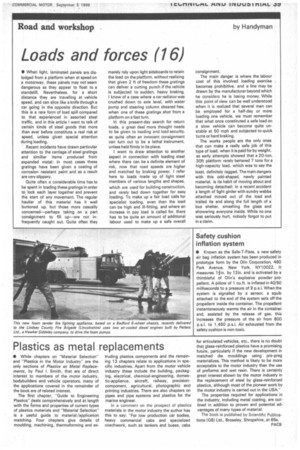Road and workshop
Page 41

If you've noticed an error in this article please click here to report it so we can fix it.
by Handyman
Loads and forces (16)
• When light, laminated panels are dislodged from a platform when at speed on a motorway, these panels may not seem dangerous as they appear to float to a standstill. Nevertheless, for a short distance they are travelling at vehicle speed, and can slice like a knife through a car going in the opposite direction. But this is a rare form of load spill compared to that experienced in assorted steel traffic, and in this article I want to talk of certain kinds of steel goods that more than ever before constitute a real risk at speed, unless given special attention during loading.
Recent incidents have drawn particular attention to the carriage of steel gratings and similiar items produced from expanded metal; in most cases these gratings have been given a coating of corrosion resistant paint and as a result are very slippery.
Quite often a considerable time has to be spent in loading these gratings in order to lock each layer together and prevent the start of any movement. The regular haulier of this material has it well buttoned up, but those more casually concerned—perhaps taking on a part consignment to fill up—are not infrequently caught out. Quite often they merely rely upon light sideboards to retain the load on the platform, without realizing that given 2 ft of freedom these gratings can deliver a cutting punch if the vehicle is subjected to sudden, heavy braking. I know of a case where a car radiator was crushed down to axle level, with water pump and steering column sheared free, when one of these gratings shot from a platform on a fast turn.
In this present-day search for return loads, a great deal more thought needs to be given to loading and load security, as quite often an innocent consignment can turn out to be a lethal instrument, unless held firmly in its place.
I want to draw attention to another aspect in connection with loading steel where there can be a definite element of risk, now that road speeds are higher and matched by braking power. I refer here to loads made up of light steel members of various lengths and shapes, which are used for building construction, and rarely bed down together for easy loading. To make up a fair load calls for specialist loading, even then the load can be high and ill-fitting, and where an increase in pay load is called for, there has to be quite an amount of additional labour used to make up a safe overall consignment.
The main danger is where the labour cost of this involved loading exercise becomes prohibitive, and a line may be drawn by the manufacturer beyond which he considers he is losing money. While this point of view can be well understood when it is realized that several men can be employed for a half-day or more loading one vehicle, we must remember that what once constituted a safe load on a slow vehicle can become quite unstable at 50 mph and subjected to quick turns or hard braking.
The works people are the only ones that can make a really safe job of this type of load, when it is paid for by weight, as early attempts showed that a 20-ton, 30ft platform rarely bettered 7 tons for a high-capacity load, which was to say the least, definitely ragged. The main dangers with this odd-shaped, newly painted material, is its habit of moving about and becoming detached: in a recent accident a length of light girder with sundry webbs attached moved out of the load and trailed its end along the full length of a bus shelter, smashing the glass and showering everyone inside. While no one was seriously hurt, nobody forgot to put in a claim.






















































































































